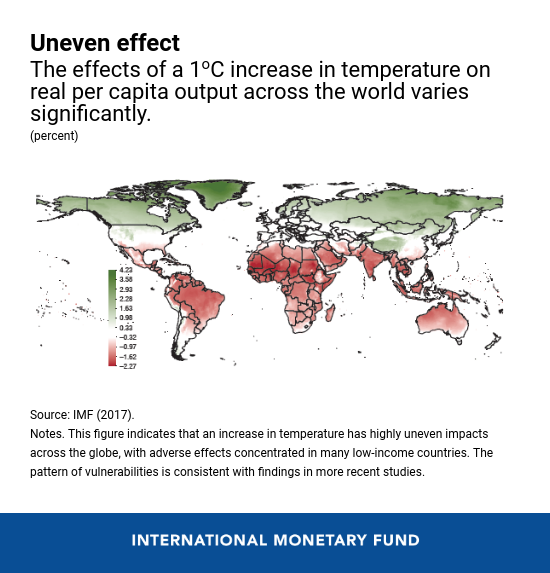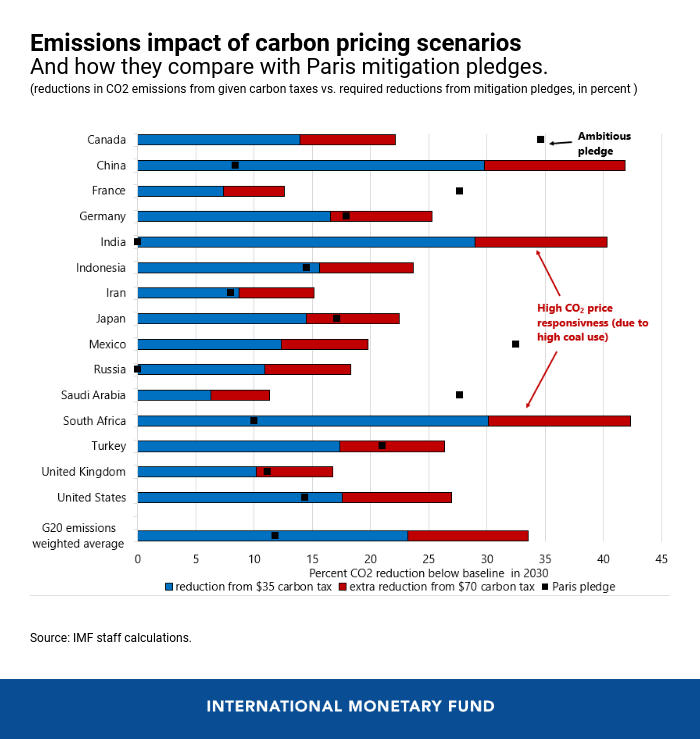عربي, 中文, Español, Français, 日本語, Português, Русский
Climate change is the great existential challenge of our times. It is a challenge that spans all regions, with especially severe consequences for low-income countries.
Without mitigating actions, global temperatures are projected to rise by 4oC above pre-industrial levels by the end of the century—with increasing and irreversible risks of collapsing ice sheets, inundation of low-lying island states, extreme weather events, and runaway warming scenarios.
A warming climate could also mean increased extinction risk for a large fraction of species, the spread of diseases, an undermining of food security, and reduced renewable surface water and groundwater resources.
The good news is that this urgent threat has inspired an unprecedented multilateral response. Altogether, 190 parties submitted climate strategies—nearly all of them with some form of mitigation commitment—for the 2015 Paris Agreement. Now is the time to think realistically about how to achieve these commitments.
The need for effective carbon pricing
There is a growing consensus that carbon pricing—charging for the carbon content of fossil fuels or their emissions—is the single most effective mitigation instrument. It provides across-the-board incentives to reduce energy consumption, use cleaner fuels, and mobilize private finance.
It also provides much needed revenues. These should be allocated to reorient public finances in support of sustainable and inclusive growth. How this is best done will differ across countries. In some cases it means investing in people and infrastructure, to attain the Sustainable Development Goals. In others it might mean reducing taxes that harm work incentives and growth.
A new IMF paper discusses how carbon prices could be used to meet Paris CO2 mitigation pledges. The pledges and required carbon prices to meet those commitments vary by country, and the paper considers the impact on CO2 emissions of $35 and $70 per ton carbon prices. A carbon price significantly below $35 per ton would be sufficient to meet the pledge for the G20 countries, which together account for four-fifths of global emissions, and this is also true for key G20 members such as China and India.
Although a $35 per ton price would roughly double coal prices, it would add only about 5 to 7 percent to pump prices for road fuels. For some countries with more ambitious pledges, however, even a $70 per ton price would fall short of what is needed.
Yet even if current pledges were fully met, they would only contain projected warming to a still quite scary 3oC, rather than the 1.5-2oC goal of the Paris Agreement. The 2oC target would require cutting emissions by roughly a third by 2030 and a global carbon price of around $70 per ton.
A first step in carbon pricing has been made with over fifty carbon tax and emissions trading systems now in operation at the regional, national, and sub-national level. There is clearly a steep uphill climb ahead, however, given that the global average carbon price is only $2 per ton.
It is also clear that carbon pricing can be politically very difficult. Events from all latitudes remind us of this. It is therefore crucial that the process be managed comprehensively. That typically involves a gradual phasing in of carbon pricing and explicit communication on the use of the associated revenue. The latter will have to balance distribution, efficiency and political considerations.
But even under these ideal conditions, we may need other instruments to reinforce carbon pricing, or even to substitute for it. The IMF paper illustrates the relevant trade-offs for 135 countries using a tool that quantifies the emissions, fiscal, and economic impacts of a range of alternative mitigation instruments. One promising approach is to avoid a politically difficult increase in fuel prices by complementing carbon pricing with revenue-neutral tax-subsidy schemes to provide further incentives for cleaner power generation, shifting to cleaner vehicles, and improvements in energy efficiency.
At the international level, ambition could be scaled up by reinforcing the Paris process with a voluntary carbon price floor arrangement among large emitters. A floor price would guarantee a minimum level of mitigation effort amongst participants while also providing some reassurance against losses in competitiveness. Advanced countries could accept a greater responsibility for mitigation through a higher minimum price requirement. And the regime could be designed flexibly to accommodate national circumstances and policies.
Climate change is the great existential challenge of our times.
Reforming energy subsidies
Another key point is that the damage done by fossil fuel energy use is not limited to climate change. Its use also gives rise to local air pollution deaths, and road congestion and accidents.
For all these reasons, many countries are getting energy prices wrong at present, even leaving aside climate concerns.
Estimates in a new IMF working paper put global subsidies for fossil fuel energy implied by the underpricing of supply and environmental costs at a staggering $5.2 trillion in 2017, or 6.5 percent of world GDP, largely unchanged from our previous estimates. Many of the benefits of price reform are local, so countries can make themselves better off, while at the same time helping to address global climate change. A key conclusion here is that solidarity is self-interest.
Almost all of those working on climate issues have bought into the idea of carbon and energy pricing reform in principle. Ministries of finance, having recognized their responsibility, will need to be nimble in seeking opportunities to provide strong incentives, mindful of the political and distributional constraints, and in creating and crafting instruments to that end. At the Fund, we remain optimistic that good practices will continue to emerge and flourish, with a catalyzing effect on others. It is difficult to understate the urgency of this task as the window for containing global warming to manageable levels is closing rapidly. Action is required by everyone, every institution, every country. Everyone can make a difference!
Related Links:
Every Day is Earth Day
5 Things You Need to Know About the IMF and Climate Change
Top 5 Blogs on Climate Change
Listen to the podcast:







